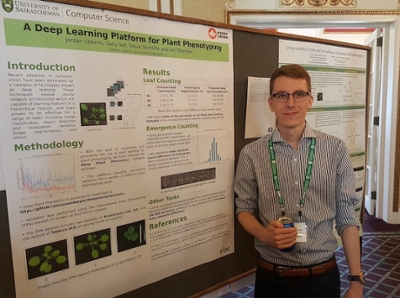
Profile: Jordan Ubbens
Applying Deep Learning to Plant Science
Jordan Ubbens, PhD Student in Computer Science (Project 3.2)
P2IRC Research: Machine Learning for Genotype to Phenotype Association
Can you tell me a bit about yourself?
I’m a PhD student here at the University of Saskatchewan. I received my bachelors and masters degrees from the University of Regina in Computer Science. Now I’m working mainly on P2IRC Project 3.2, but I also work with Projects 3.3 and 3.5. I work on mostly image analysis, deep learning, and machine learning. I also work a little with simulation and modelling – I spent a semester in Calgary working at the algorithmic botany lab there.
Can you provide a brief summary of your research?
Deep learning is a subfield of machine learning. For example, deep learning is the visual technology used in self-driving cars. Most of my research has been about the application of deep learning to plant phenotyping. I’ve published papers about using deep learning for various phenotyping problems. In Project 3.2, we’re also interested in the broader application and integration of deep learning into systems that we’re developing for P2IRC.
What do you enjoy most about your research?
Machine learning in the plant science domain is still very new, so it’s exciting to be able to do the initial exploration in this interdisciplinary space.
I like the interdisciplinary aspect of it – P2IRC involves so many collaborators with different backgrounds, and interfacing with their research and problems. I like being able to contribute to solving their problems.
Why is your project important?
Developing new tools for plant scientists is very important at this point, since we have acknowledged there is a gap between phenotyping and genotyping technologies. Closing this gap will help advance the field in general.
What are some potential applications of your project?
We have released software that can be used with any high throughput phenotyping data, whether in commercial or academic applications. This helps to process the large amounts of data generated by these high throughput systems.
What is one of the biggest challenges you’ve faced as a researcher?
The interdisciplinary part is a big challenge – trying to find a common language with geneticists and agronomists, and truly understanding their problems.
What is one of the most interesting findings that you’ve had to date?
Earlier this year, we published one of the first studies, showing structural plant modelling paired with deep learning. This collaboration showed how structural models can contribute to the machine learning problem, where we don't have a lot of training data. This is a great application of the expertise we already have in structural modeling to problems in machine learning and agriculture.
How have you grown or developed as a professional because of your research?
I understand a lot more about plant science than when I entered. Sometimes I have the privilege of sitting in on team meetings for other sub themes. I’ve gotten to the point where I can now follow along and understand.
Publications:
- The Use of Plant Models in Deep Learning: An Application to Leaf Counting in Rosette Plants
- Deep Plant Phenomics: A Deep Learning Platform for Complex Plant Phenotyping Tasks
Personal Website: http://www.jordanubbens.com
Deep Plant Phenometrics Software: https://github.com/p2irc/deepplantphenomics

